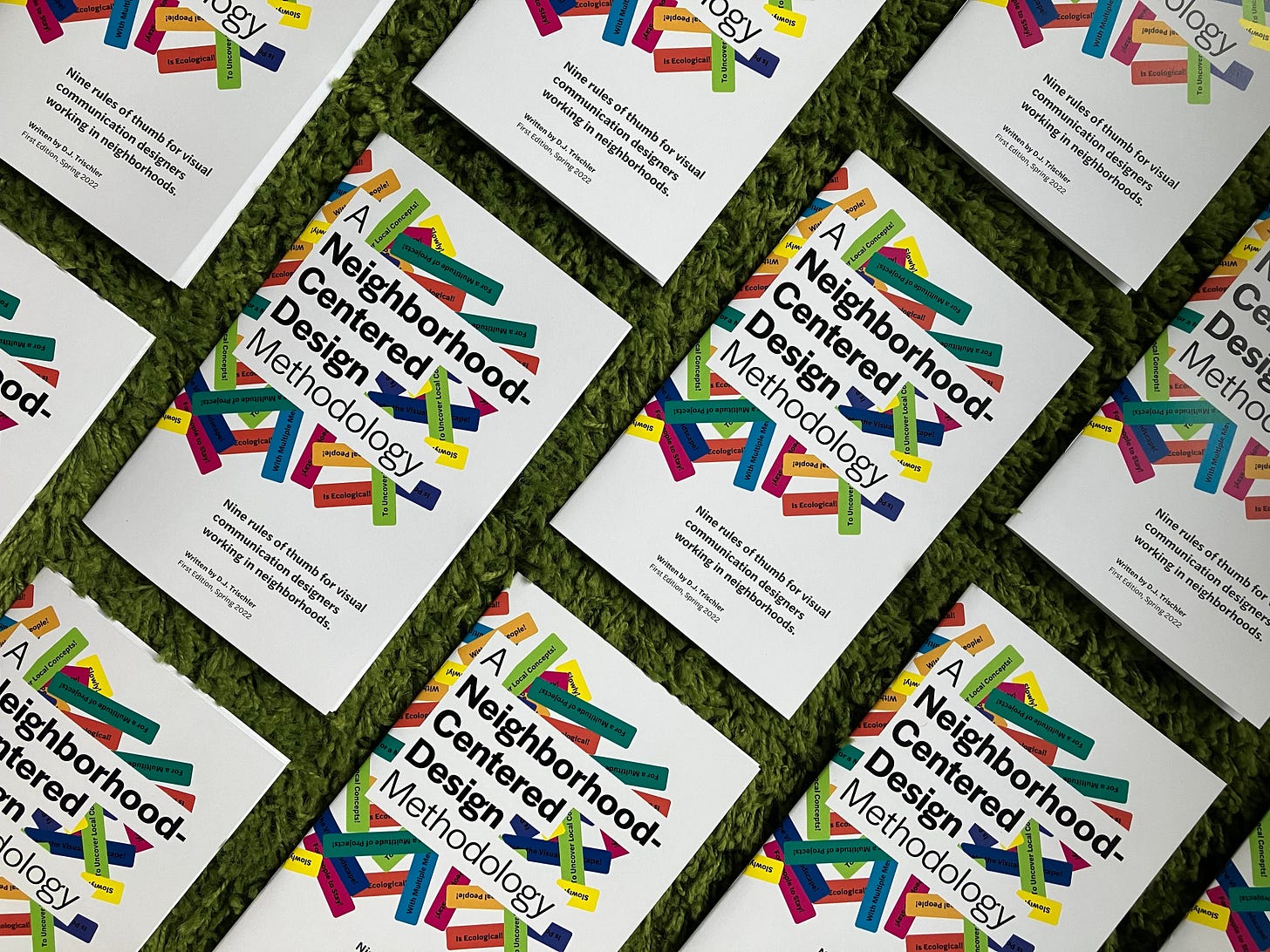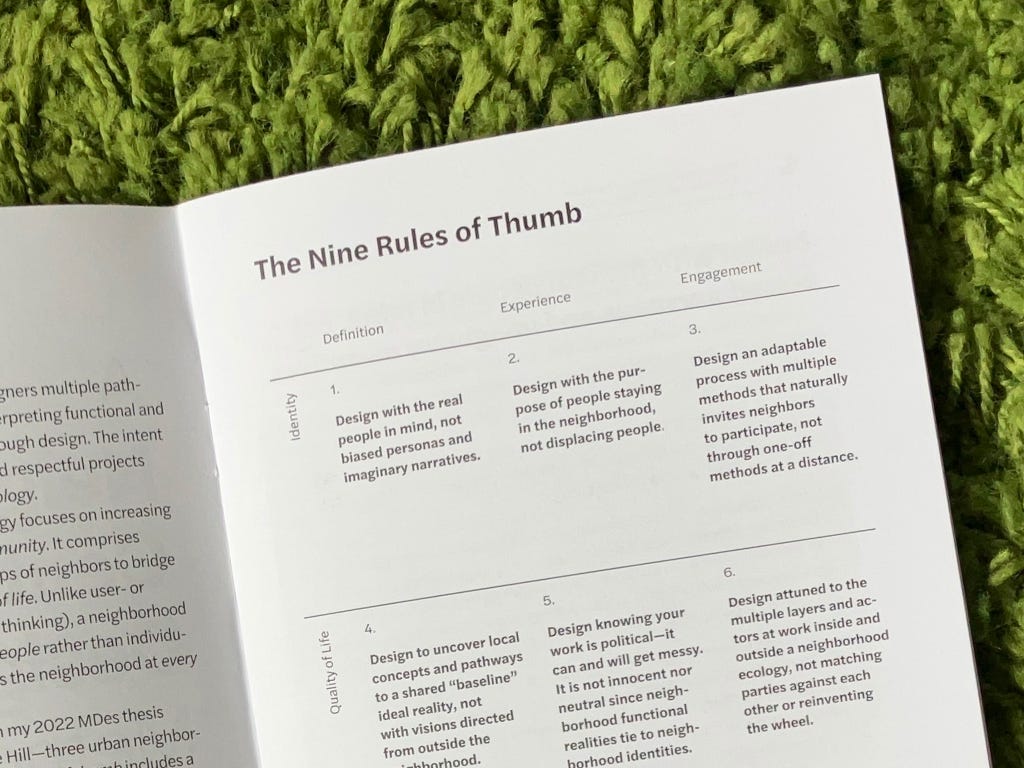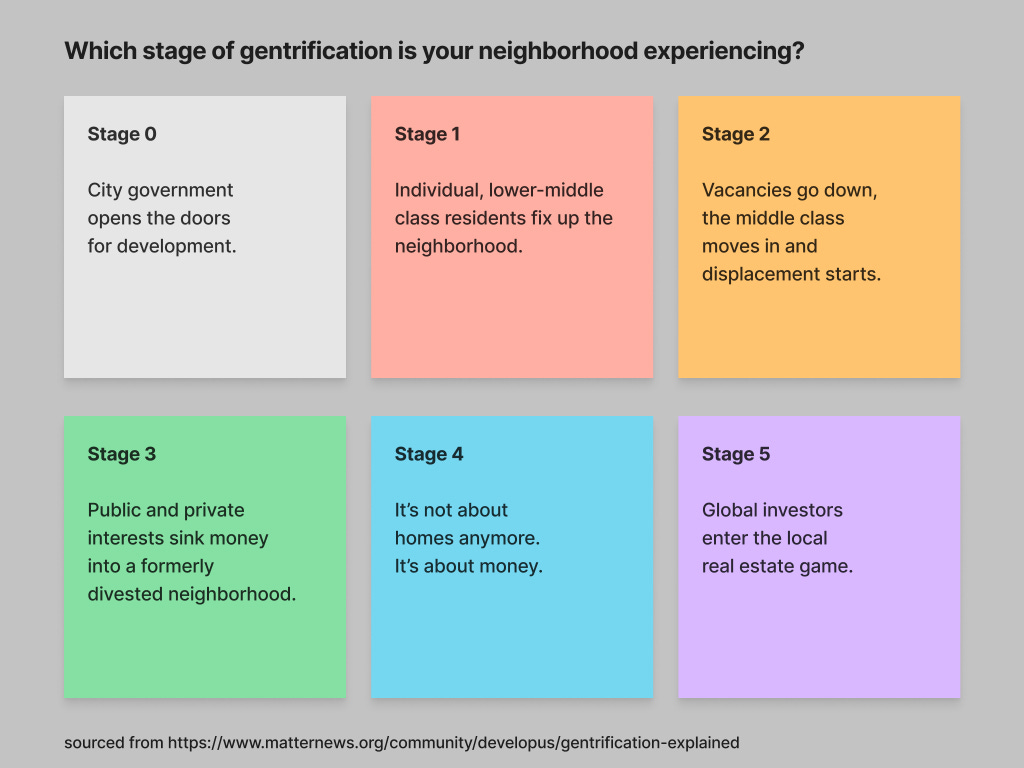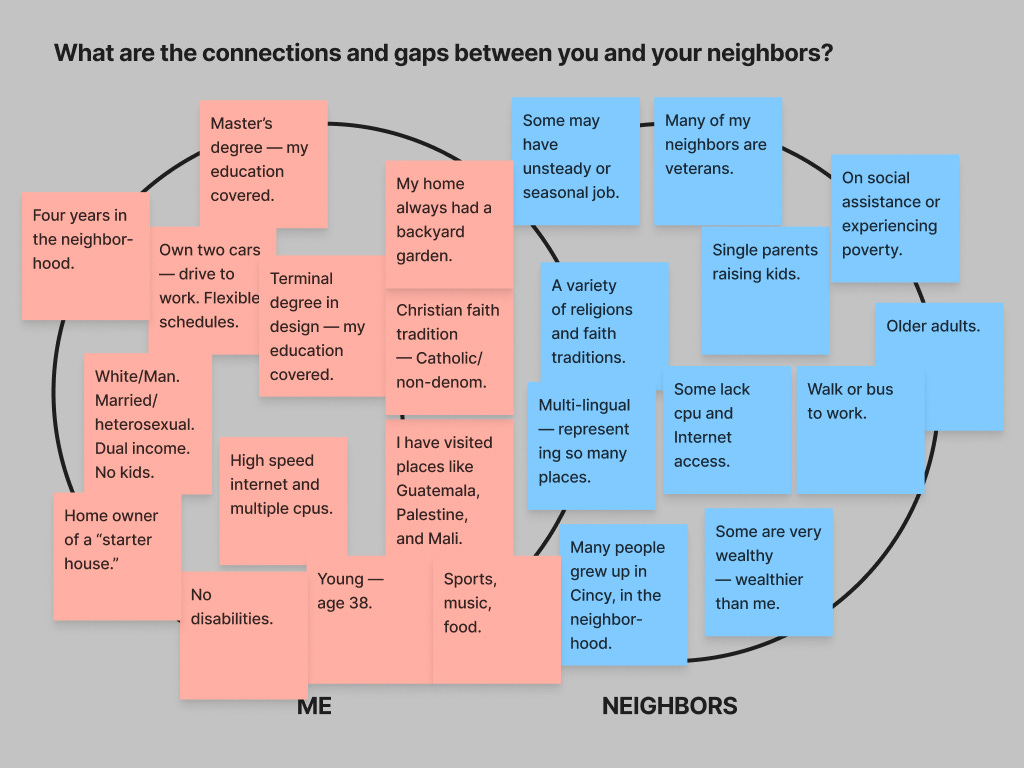
Introduction
For those reading this Substack for the first time, I am unpacking the rules of thumb and project cues in my guide, A Neighborhood-Centered Methodology1.
The methodology resulted from my Master of Design2 thesis study within Cincinnati, Ohio's three Price Hill neighborhoods. I am further unpacking the rules and cues through a Substack because there is so much more to say than could fit in a 7500-word thesis. Additionally, many readers in my audience (visual identity and communication designers) will not reach for a graduate research manuscript or peer-reviewed scholarly articles when seeking resources to edify their work.
I did the best I could as a designer — not an anthropologist or a sociologist — to represent the communities in Price Hill and identify a framework for visual communication designers working in the neighborhoods through my research.
The University of Cincinnati's Institutional Review Board deemed the research non-human subject research since the study was site-specific to Price Hill.3 Further, much more evaluation of the methodology in Price Hill and beyond is required. As such, please read the contents of the guide and these articles as a work-in-progress that requires development by myself and other neighborhood-centered designers.
Likewise, this methodology though linear does not mandate a prescriptive order.
Try the methods in differing sequences throughout the design process, doing and re-doing them along the way.
With those disclaimers established, let us return to the Rules of Thumb!
Rule of Thumb Two
The guide's first three rules of thumb focused on a neighborhood's identities.
They were meant to help designers and their partners uncover an understanding of — empathy for — the neighborhood's population. The last issue concentrated on Rule of Thumb 01 and the racial and ethnic migrations to and from Price Hill.
Rule of Thumb 02 states, "Design with the purpose of people staying in the neighborhood, not displacing people."
In the guide, I focused on housing affordability — not inadvertently stepping into a gentrification or forced displacement process, specifically by raising local taxes. Looking at the history of migration in the previous issue, we can see how displacement — people forced to move from one place to another, not by choice — driven by multiple STEEP factors inside and outside the neighborhood constructed Price Hill's current population.
In this article, we will expand on the last issue's discussion by looking at the social status of your team and the neighborhood and which stage of gentrification the community is experiencing before your project.
While I touched slightly on social status in the last issue, the focus was predominantly on race and ethnicity. Race, ethnicity, and social status intersect with each other. Other intersectional identifiers include but are not limited to gender, sexuality, abilities, faith traditions, and age. Examining these various intersections is called intersectionality.4 Assessing intersectionality provides more dimension in a neighborhood than race or ethnicity alone — it creates a more kaleidoscopic picture. By adding social status we are ultimately looking at the power distribution inside and outside a neighborhood. In other words, who has "the capacity to achieve outcomes?"5
Look at your Team.
Before looking at the neighborhood further, I invite you to examine the social status of yourself and your team.
Reflecting on our social position is called positionality. It matters tremendously because our social status often defines how we view the world and how others view us, shaping everything we do and what is done in our lives.6
For instance, I grew up in the United States and know libraries are free because my mom — who chose not to work full-time — drove me to the local Carnegie Library weekly. If I assume everyone knows this information or has the same access, I will overlook many Mexican and Central Americans in my neighborhood who believe libraries are for people in universities; they are not accessible to everyone.
Another example is that as a white man, I can walk my neighborhood with less concern than a woman. It is a privilege that I quickly take for granted. Women in the community may hear catcalling and sense the gaze of others objectifying them. Police may treat them as sex workers. Their walk on the same sidewalk is a different experience than mine.
Consider the following questions as you start thinking about your and your team's positionality concerning the neighborhood.
What does your social sphere look like?
How are you already involved or not involved in the community?
Are you designing from within or outside the community?
What financial and social capital do you have to gain from the project?7
Are you in the position of giving charity or receiving charity, or does the project invite participation via mutual aid?8
If giving charity, what do you get in return? Does it make you feel good? Will it change how others think about you or your team?
Who is supporting your work? Where does their capital come from?
What risks does the project have on your livelihood? How does your level of risk differ from someone with different intersectional identities?
What do you and your team think is a good outcome?
Going deeper, Design scholar Leslie Ann Noel made a "Who am I" Positionality Wheel to investigate one’s social status.9
Complete the Positionality Wheel worksheet yourself and discuss the feelings that surface with your teammates (at your comfort level). I recently used this chart with first-year students in an intro to design course. It was interesting how some students from more privileged positions wrote reflections that referred to the potential liability of their positionality.
This space of personal investigation into positionality is ripe for expression through visualizations.
Phillip Ely suggests visualizing our life histories to understand which side of global colonization one resides.10 These “influence maps” add a broader perspective to the Positionality Wheel, showing interrelationships with the social, technological, environmental, economic, and political (STEEP) factors that constructed our lives (much like how they construct a neighborhood).
I have invited students to make a non-linear collage of their life histories and write a verbal reflection in response to the image. I am amazed by and respect my students' vulnerability in their self-reflections — they share moments that shape their lives.
By looking at what shapes one's life before a design project, we can start to understand our potential to shape others' lives through a design project.
Design is a huge responsibility; these efforts to look within and around ourselves help us not take our work for granted. These tools will not cure all social ailments and alienation. Still, they can spark conversations and reflection that lead to better actions with an understanding of potential unintended outcomes resulting from shallow worldviews.11
Look at the Neighborhood.
Next, let's look closer at the constituents of a neighborhood and their relation to power by asking the following questions.
Who is your audience?
Is the audience inside and/or outside of the neighborhood?
Who are you designing for inside the neighborhood?
Who are you designing for outside the neighborhood?
Who are you working with, and how are they connected to others in the neighborhood?
Who is seeking justice in the neighborhood?
Who can achieve their desired outcomes?
Who are the poor — those with the least power — in the neighborhood?
How does the project put neighbors at risk?
What does it look like to treat every neighbor with dignity and respect?
What social and financial capital do neighbors receive immediately in return for their participation?
How will they benefit from the long-term results of the project?
What do different people in the neighborhood believe is a good project outcome?
Where might the constituents fall on Noel’s Positionality Wheel?
Recent census data is helpful here. The 2020 Census of Cincinnati neighborhoods shows essential information about households, how many people have an internet connection and a computer, transportation methods, income levels, education status, and more.12
Through this process, you may discover that some neighbors may be experiencing existing or prior trauma incurred inside and outside the neighborhood.
How might you carry trauma awareness into your project?13 Can you invite social workers or collaborate with a community psychologist who can foster liberatory design processes for all neighbors?14
Lastly, as we continue examining social status in the neighborhood, what phase of gentrification is the neighborhood experiencing?
Often, it is not about if gentrification exists but how. An article out of nearby Columbus, Ohio, outlines the six phases of gentrification, starting with phase 0 and ending with phase 5.15 Identifying the current phase mitigates further displacement and class separation caused by seemingly positive intentions.
For instance, a research paper from a neighborhood in Buffalo demonstrated that even well-intentioned creative projects could propel social divides.16 This happens overtly (razing buildings for new condos) or symbolically (making neighbors feel like they do not belong in the community because the amenities are no longer theirs). Recently, residents in a Cincinnati neighborhood near downtown said a doughnut shop didn't feel it was for them — both price and aesthetics mattered.17
Fighting gentrification involves many tactics, but as designers, we can start by asking what is affordable (price) and feels approachable (aesthetically) for your neighbors and actively work against premiumizing your neighborhood.18
You, like me, may love the look and feel of third-wave coffee shops and think your neighborhood needs amenities or a vibe similar to these and other trendy spaces. But $1.00 McDonald's coffee or inexpensive drip coffee made by local store owners might be good enough to construct an equitable communal space in your neighborhood.19
Visual designers must consider the words and images within a neighborhood's visual landscape.20
Anthropologists in Brooklyn painted a picture of gentrification's evolution through the changes in storefront signs.21 Before significant redevelopment, immigrants often ran or owned the stores presenting DIY signage applications — often not "clean," graphically speaking. The researchers categorized these signs as "capitalism without distinction."22 On the other end, they collected super "clean" (premium) facades of restaurants with minimal signage, often using shorter words with esoteric meanings and usually sourced from obscure languages. The authors categorize these signs as "capitalism with distinction." Though often independently owned, these spaces attracted more corporate-owned companies to the area, neutralizing the former eccentric and authentic representations of the community.
Are you missing the vibrant spaces where micro-communities of your neighborhood thrive because they do not meet the taste levels driven by your social status?
Are you primarily chasing capital and favoring those with money? Unfortunately, neighborhoods are forced in this direction — toward place branding23 — since there is a severe lack of funding from local and national governments.24 Still, how might you, your team, and your partners open your eyes beyond dollar signs as a singular metric and look at all of your neighbors — of high and low social status and taste levels — who already live and work in your neighborhood?
Seeing Both Sides Now
Now that you have looked at your team, yourself, and the neighborhood, what have your learned?
I sketched the simplified Venn Diagram above in FigJam to illustrate the gaps and connections between my neighbors and me. The visualization helps me look at my credibility (or lack thereof) when offering design services in this space.
As an academic, one of the more significant gaps falls between my learned experience and my neighbor's lived experience. I have been living in working in my neighborhood for merely a few years. Often, my knowledge comes from reading case studies and theories about public space (see my bibliography below). My neighbors, however, have much more life or lived experience living and working near their neighbors. In many ways, my neighbors are the experts, and I am the student.
As Joanie Mitchel might put it, I really do not know my neighborhood at all.25
Going into a neighborhood with a student’s or beginner's mindset is difficult but essential. There is no place for the designer's ego here because it will kill creative collaborations quickly. Instead, work vigilantly to stay curious about and in proximity to your neighbors.
A small community-run grocery store near my house is an excellent example of staying curious about their neighbors.
You'll often find a D.I.Y. poster board in a bathroom asking neighbors questions about bettering the store. They are curious about everything from what wall colors the community likes to the types of foods and products people the store offers. Anyone can participate, from kids to older adults. Through their deep curiosity and community connection, the grocery store does not fall into the illusions of "capitalism with distinction" category or pricing and selling products to an audience outside its immediate boundaries. Instead, the store’s team works hard to foster a deep sense of respect and dignity for their neighbors, shaping a sense of community that attracts people inside and outside the neighborhood.
How can you and your team, like the grocery store, communicate respectfully with all neighbors, regardless of social status and taste levels?
With these thoughts in mind, step into the community, in proximity to your neighbors — if you have not already — as an observer or participant observer. Join a neighborhood group (online or offline), volunteer at a school or after-school program, attend a local place of worship, walk the neighborhood at various hours, shop in the local stores, and talk to your neighbors.
In the next post, I will write more about connecting with neighbors through research and design methods.
For now, start to be with your neighbors with no research agenda.
Citations and Footnotes
Click or tap here to read the guide. Do you want a free print copy? Email me. I will cover the postage and handling.
I now teach as an assistant professor in the Ullman School of Design at DAAP within the Univesity of Cincinnati. Click or tap here to come to learn with me.
For those unaware of an Institutional Review Board (IRB), it is an office within a research university — and sometimes within communities — that reviews research plans, ensuring faculty and the institution do no harm. IRB also gauges whether or not a project is “human-subject research,” which qualifies as a systematic study involving humans that will produce knowledge for use, often beyond the research site. IRB concluded that my research was “non-human subject research” because even though my project involved humans, my thesis results were site-specific — useful for place-branding and visual communication design projects in Price Hill.
One might think that professional researchers would not require an IRB office, but the University of Cincinnati's history proves their need.
Costanza-Chock, S. (2020). Design Justice. MIT Press. https://play.google.com/store/books/details?id=m4LPDwAAQBAJ&source=gbs_api
In the book, Costanza-Chock writes that intersectionality “refers to the way that structural oppression is not based only on race or gender identity, but on the intersection of race, gender identity, sexual orientation, class, immigration status, disability, age, and other axes of identity.”
Mayorga-Gallo, S. (2014). Behind the White Picket Fence. UNC Press Books. http://books.google.com/books?id=kl6CBAAAQBAJ&hl=&source=gbs_api
I borrowed this definition from Sarah Mayorga Gallo, who borrowed it from social theorist Anthony Gidden’s conceptualization of power.
Click here to learn more about positionality as well as intersectionality and privilege.
Putnam, R. D. (2001). Bowling Alone. Simon and Schuster. https://play.google.com/store/books/details?id=cettawwJwxsC&source=gbs_api
Putnam writes that social capital “calls attention to the ways in which our lives are made more productive by social ties.”
Rebecca Solnit’s book A Paradise Built in Hell: The Extraordinary Communities That Arise in Disaster shares moving accounts of mutual aid after historical disasters. The stories within her book had a significant impact on my thesis direction.
Dean Spade also wrote a lovely book on how to do Mutual Aid titled Mutual Aid: Building Solidarity During this Crisis (and the Next).
There is a link to download a PDF of the Positionality Wheel toward the bottom of the page.
Ely, P. (2020). Designing Futures for an Age of Differentialism. Design and Culture, 12(3), 265-288. https://www.tandfonline.com/doi/abs/10.1080/17547075.2020.1810907
Unfortunately, the article above is behind a paywall. Click or tap here for an open article on designing system maps that resemble life history diagrams/collages/sketches.
Antionette Carroll of Creative Reaction Lab redefines IBM’s description of design from “the intent behind an outcome” to “the intent and unintentional impact behind an outcome”.
Click or tap here for the Cincinnati census data portal.
Click or tap here for an article on trauma-responsive research practices.
Visit the Liberatory Design website for more information on and tools for bringing theories of liberation into your design practice.
Twigg, M. (2020, August 20). Revitalization or displacement: What is Gentrification Really? Matter News. Retrieved March 6, 2023, from https://www.matternews.org/community/developus/gentrification-explained
Willer, C. J. (2021). Rebranding place “To Build Community”: Neighborhood Branding in Buffalo, NY. Urban Geography, 1-22. https://doi.org/10.1080/02723638.2021.1927323
Lumpkins, B. (2021, August 5). Cincinnati's Black Population is Decreasing. Here's Why and its Potential Impacts. The Enquirer. Retrieved March 6, 2023, from https://www.cincinnati.com/story/news/2021/08/05/poverty-rise-and-black-cincinnati-families-being-pushed-suburbs/7642835002/
This article introduced me to the term symbolic displacement.
Karaian, J., & Smialek, J. (2023, March 4). Is the entire economy gentrifying? The New York Times. Retrieved March 7, 2023, from https://www.nytimes.com/2023/03/04/business/economy/premium-prices-inflation.html?smid=nytcore-ios-share&referringSource=articleShare
Gumbiner, D. (2022, December 8). Place: McDonald's, 24th and Mission Streets, San Francisco. Believer Magazine. Retrieved March 6, 2023, from https://www.thebeliever.net/place-mcdonalds-24th-and-mission-streets-san-francisco/
Aside from the Kroger coffee I make via pour-over at home, my favorite cup of coffee in the neighborhood comes from the back room of a thrift shop — made with love — by the owners, who always offer me a cup of joe as soon as I enter their store.
We will go more in-depth on this topic in Rule of Thumb 07 – 09.
Trinch, S., & Snajdr, E. (2017). What the signs say: Gentrification and the disappearance of capitalism without distinction in Brooklyn. Journal of Sociolinguistics, 21(1), 64-89. https://onlinelibrary.wiley.com/doi/am-pdf/10.1111/josl.12212
Click or tap here to see the book that came after this article.
Want to go deeper? Click or tap here to learn more about Pierre Bourdieu’s writing on class distinction and taste.
Collins, B. (2021). Place branding and its Discontents: The Politics and Management of Neighborhood Governance Systems. Journal of Planning Education and Research, 0739456X21998448. https://journals.sagepub.com/doi/abs/10.1177/0739456X21998448
The author defines place branding as “a process of shaping the public perception of a place through activities that positively communicate a place’s uniqueness and quality of life.” I will dive further into place branding in Rule of Thumb 04.
Click or tap here to return to the last issue, which concerns decreased government spending in neighborhoods. This reality is a symptom of what academics call neoliberalism.
While refining this post, I listened to Joanie Mitchel, and I am starting to think the lyrics for Both Sides Now offer wisdom for the neighborhood-centered designer.





